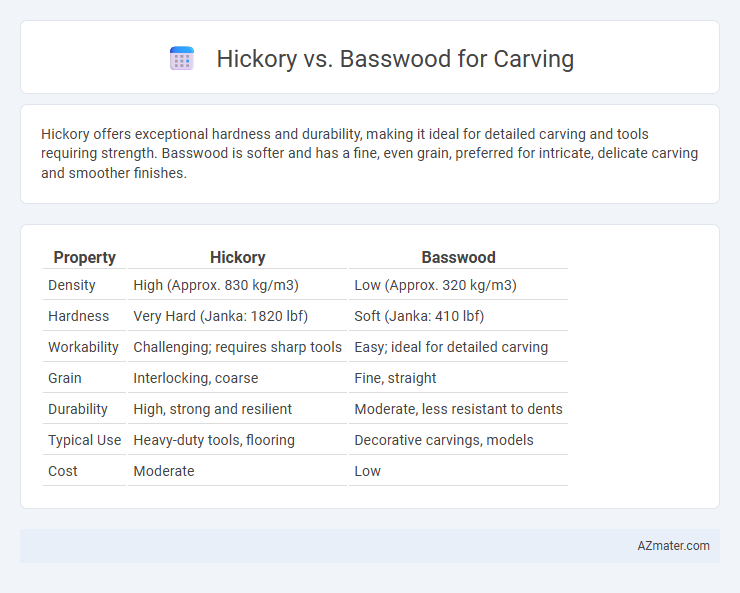Hickory offers exceptional hardness and durability, making it ideal for detailed carving and tools requiring strength. Basswood is softer and has a fine, even grain, preferred for intricate, delicate carving and smoother finishes.
Table of Comparison
| Property | Hickory | Basswood |
|---|---|---|
| Density | High (Approx. 830 kg/m3) | Low (Approx. 320 kg/m3) |
| Hardness | Very Hard (Janka: 1820 lbf) | Soft (Janka: 410 lbf) |
| Workability | Challenging; requires sharp tools | Easy; ideal for detailed carving |
| Grain | Interlocking, coarse | Fine, straight |
| Durability | High, strong and resilient | Moderate, less resistant to dents |
| Typical Use | Heavy-duty tools, flooring | Decorative carvings, models |
| Cost | Moderate | Low |
Introduction to Hickory and Basswood for Carving
Hickory is a dense, hard wood prized for its strength and durability, making it ideal for detailed carving that requires longevity and resistance to wear. Basswood, a softer hardwood with a fine, even texture, is favored by carvers for its ease of cutting and smooth finish, especially in intricate and delicate designs. Both woods offer unique advantages, with hickory suited for robust projects and basswood preferred for precision and ease of shaping.
Wood Characteristics: Hickory vs Basswood
Hickory is a dense and hard wood with a Janka hardness rating of 1,820, providing excellent durability and strength for carving projects requiring resilience. Basswood, with a much softer texture and a Janka rating of 410, is favored for its fine, even grain and ease of carving, especially for intricate detail work. The distinct hardness levels influence tool wear and carving speed, making basswood ideal for beginners or detailed carvings, while hickory suits robust, functional pieces.
Workability and Carving Ease Comparison
Basswood is highly favored for carving due to its soft texture and fine, even grain, which allows for smooth cuts and intricate detail work with minimal effort. Hickory, while significantly harder and denser, provides superior durability but demands sharper tools and greater strength, making it less forgiving for beginners. Carvers seeking ease and precision often prefer basswood, whereas those requiring toughness and resilience lean toward hickory despite its challenging workability.
Grain Structure and Texture Differences
Hickory features a coarse, interlocked grain structure with a dense and tough texture, making it highly durable but more challenging to carve fine details. Basswood exhibits a fine, even grain structure with a soft, smooth texture, allowing for effortless cutting and intricate detail work in carving projects. The grain of basswood is less pronounced, which helps prevent splitting and makes it the preferred choice for beginner carvers and detailed sculptures.
Durability and Strength in Carved Pieces
Hickory offers superior durability and strength compared to basswood, making it ideal for carved pieces that require long-lasting resilience and the ability to withstand impact. Basswood, being softer and lighter, is easier to carve but results in less robust artworks prone to dents and wear over time. Choosing hickory enhances the longevity and structural integrity of heavy-use carvings, while basswood suits delicate, detailed projects with lower durability demands.
Suitable Carving Projects for Each Wood
Hickory's dense, tough grain makes it ideal for heavy-duty carving projects such as tool handles, mallets, and rustic furniture, where durability and strength are essential. Basswood is favored for detailed and delicate carving, perfect for intricate sculptures, reliefs, and decorative items due to its soft texture and fine, uniform grain. Carvers often choose basswood for beginner projects and fine detailing, while hickory suits more rugged, functional works requiring resilience.
Finishing and Detailing Results
Hickory offers a dense, hard texture that holds fine details exceptionally well during carving, resulting in crisp, durable finishes ideal for intricate patterns. Basswood's softer, even grain allows for smoother cuts and easier finishing but may not preserve sharp details as precisely as hickory. When choosing between the two, hickory is preferred for projects requiring lasting detail and toughness, while basswood suits smoother finishing and ease of work for delicate designs.
Cost and Availability Analysis
Hickory and basswood present distinct differences in cost and availability for carving projects. Hickory is generally more expensive due to its durability and density, often sourced from the eastern United States, making it less readily available in some regions. Basswood tends to be more affordable and widely accessible, favored for its soft texture and ease of carving, with abundant supplies primarily from North American hardwood forests.
Pros and Cons: Hickory vs Basswood
Hickory offers exceptional strength and durability, making it ideal for carving tools with high impact resistance, but its dense grain can be tough to carve and may dull blades quickly. Basswood is softer with a fine and even grain, allowing for detailed and smooth carving, which is perfect for beginners or intricate designs, though it lacks the structural strength for heavy-duty projects. Choosing between Hickory and Basswood depends on the balance needed between carving ease and the final workpiece's toughness.
Choosing the Right Wood for Your Carving Project
Hickory offers exceptional strength and durability, making it ideal for projects requiring detailed, resilient carvings with a firm grip. Basswood, known for its fine grain and softness, allows for easier cuts and intricate detail work, especially suited for beginners and delicate designs. Selecting between hickory and basswood depends on the intended use, carving style, and the desired balance between durability and ease of carving.

Infographic: Hickory vs Basswood for Carving
 azmater.com
azmater.com